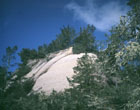
Trees growing on a sandstone outcrop at the Bonnie Doon site [V. Dinets, 2003.03].

Dwarf trees growing in sandstone at the Bonnie Doon site [V. Dinets, 2003.03].
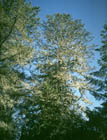
Large tree growing in soil at the Bonnie Doon site [V. Dinets, 2003.03].

The Bonnie Doon site in recovery from the 2008 Martin Fire [C.J. Earle, 2013.01.20].
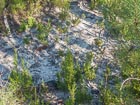
Abundant regeneration after the Martin Fire [C.J. Earle, 2013.01.20].
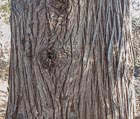
Bark on a tree about 35 cm diameter at the Bonnie Doon site [C.J. Earle, 2013.01.20].

Second-year seedling 8.5 cm tall at the Bonnie Doon site [C.J. Earle, 2013.01.20].

The unburned stand, seen from the edge of the burn, contains mature Cupressus mixed with Pinus attenuata [C.J. Earle, 2013.01.20].
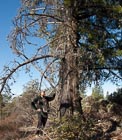
Largest tree found at the Bonnie Doon site; half of its crown had been killed by fire scorch [C.J. Earle, 2013.01.20].
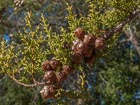
Branch, cones, and foliage; at the Bonnie Doon site [C.J. Earle, 2013.01.20].
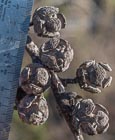
Cones that, burned by the fire, opened and spread their seed [C.J. Earle, 2013.01.20].

Conservation Status

Hesperocyparis abramsiana
(C.B.Wolf) Bartel (2009)
Common names
Santa Cruz cypress.
Taxonomic notes
Synonymy: see POWO (accessed 2023.12.16). The type locality is the Bonnie Doon grove, described below. Although collected as early as 1881, specimens were described as H. sargentii or H. goveniana until Wolf (1948) described the new taxon. He regarded the taxon as intermediate between the coastal H. goveniana and the widespread, interior species, H. sargentii (Griffin and Critchfield 1972). McMillan (1951) proposed a hybrid origin from these two species, but the idea has not been widely credited. Molecular analysis of several types of genetic material has confirmed a close relationship to H. goveniana, and many authorities regard this as a subspecies or variety of that taxon (Little 2006).
Description
Shrubs or trees usually to 10 m tall; crown globose to columnar, dense or sparse. Bark smooth or rough, fibrous. Twigs decussate, 1-1.5 mm diameter. Leaves without abaxial gland or sometimes with embedded abaxial gland that does not produce drop of resin, not glaucous. Pollen cones 3-4 × 1.5-2 mm; pollen sacs 3-6. Seed cones globose, (15-)20-30 mm diameter, brown, not glaucous; scales 3-5 pairs, smooth, umbo nearly flat at maturity. Seeds 3-4(5) mm, brown, often glaucous. It can be distinguished from H. goveniana or H. pygmaea by its large cones, its brown and often glaucous seeds, and by its very isolated native range (Eckenwalder 1993, Wolf 1948, Farjon 2005). See García Esteban et al. (2004) for a detailed characterization of the wood anatomy.
Distribution and Ecology
USA: California, Santa Cruz Mountains, at 490-760 m (Peattie 1950). Found at 2 locales in Santa Cruz County and one in adjacent San Mateo County (Little 1970). Hardy to Zone 8 (cold hardiness limit between -12.1°C and -6.7°C) (Bannister and Neuner 2001).
Data from USGS (1999).
Griffin and Critchfield (1972) provide the following detail on this species' native occurrence: "This cypress is confined to four populations in the Santa Cruz Mountains. Wolf (1948) discussed the Bonny Doon and Eagle Rock groves. The Butano Ridge stand, which Wolf looked for but could not find, was relocated in 1949 (McMillan 1952). ... [A] fourth stand [was found] near Boulder Creek which Thomas (1961) called the Brackenbrae grove. These cypress populations all grow in sterile, sandy, chaparral habitats within a Redwood-Mixed Evergreen Forest mosaic. The southernmost grove, along Martin Road near Bonny Doon, is probably the best known stand. These cypresses, at [490 m] elevation, associate with knobcone pine [Pinus attenuata] on sandstone outcrops and with ponderosa pine [Pinus ponderosa] on deeper soils. [Eleven km] north, near Eagle Rock lookout, is the smallest grove. This stand numbers less than a hundred trees. At [762 m], it is the highest-elevation grove. The larger Brackenbrae population is [4.8 km] east of Eagle Rock. It lies on the east side of Boulder Creek canyon around the [328-meter] level. The cypress trees are scattered within knobcone pine thickets. The northernmost stand is [11.25 km] northwest of Eagle Rock on the south side of Butano Ridge."
About half of the Bonnie Doon grove, including the area supporting ponderosa pine, was burned in the Martin Fire in 2008. As shown in photos at right, the fire was intense, with near 100% tree mortality in the burned area; however Hesperocyparis and Pinus attenuata regeneration were both abundant in the burned area when I visited in 2014.
In 1987, the U.S. Fish and Wildlife Service listed this as an endangered species C. abramsiana; that status was downlisted to "threatened" in 2016. Relevant documents, including a recovery plan, are located on the web (the USFWS is constantly reorganizing their websites, so it's hard to provide a link).
Remarkable Specimens
See Observations, below, and photo, at right.
Ethnobotany
No data as of 2023.12.16.
Observations
Vladimir Dinets (e-mail 2003.03.01) reports that it can be seen at the Bonnie Doon Ecological Preserve. "The reserve protects an unusual area of sandstone outcrops, surrounded by sandy flats with tall forest of ponderosa pine (the best one anywhere on Calif. coast). It has two endemic plant species. Overall, the place looks like a piece of Eastern Sierra transported to the coast. The largest cypress trees are more than 25 m tall, and (not the same specimens) approach 50 cm in diameter. There are also some dwarf trees, one had a cone but was only 15 cm tall."
Directions: From Santa Cruz, take Highway 1 north for a few miles. Before reaching Davenport, turn right on Bonny Doon Rd. Follow it for about 5 miles. Soon after it becomes Pine Flat Rd., turn right on Martin Rd and drive another mile or two. Park near volunteer fire station on the left; this is a recognized trailhead with signage, located in the midst of the burned area. The trails lead east, across the road, but the best cypress stand is visible to the west, across the burn.
Remarks
The epithet honors Leroy Abrams (1874-1956) "Emeritus Professor of Botany and Director of the Natural History Museum of Stanford University, author of an Illustrated Flora of the Pacific States, a Phytogeographic Study of the Trees and Shrubs of Southern California, author of Cupressus nevadensis, one of the most beautiful of the California species, and a member of the Advisory Board of Rancho Santa Ana Botanic Garden. In 1937 Dr. Abrams examined and studied the cypress trees with me at Bonnie Doon" (Wolf 1948).
Citations
[Bartel 2009] Adams, R. P., J. A. Bartel and R. A. Price. 2009. A new genus, Hesperocyparis, for the cypresses of the western hemisphere. Phytologia 91(1):160-185.
McMillan, Calvin. 1952. The third locality for Cupressus Abramsiana Wolf. Madroño 11: 189-194. Available: Biodiversity Heritage Library, accessed 2021.12.18.
Thomas, J.H. 1961. Flora of the Santa Cruz Mountains of California. 434 p., illus. Stanford: Stanford Univ. Press.
U.S. Fish and Wildlife Service. 1998. Recovery Plan for the Santa Cruz Cypress (Cupressus abramsiana). U.S. Fish and Wildlife Service, Portland, Oregon. 51pp. + appendices.
See also
The species account at Threatened Conifers of the World.
Adams, R. P. and J. A. Bartel. 2009. Geographic variation in the leaf essential oils of Hesperocyparis (Cupressus) abramsiana, H. goveniana and H. macrocarpa: Systematic implications. Phytologia 91(1):226-243.
Adams, R. P. and J. A. Bartel. Infraspecific variation in Hesperocyparis abramsiana: ISSRs and terpenoid data. Phytologia 91(2);287-299.
Eckenwalder (1993).
Wolf's original description is online at http://www.cupressus.net/CUabramsianaWolf.html, courtesy of the Cupressus Conservation Project website.











